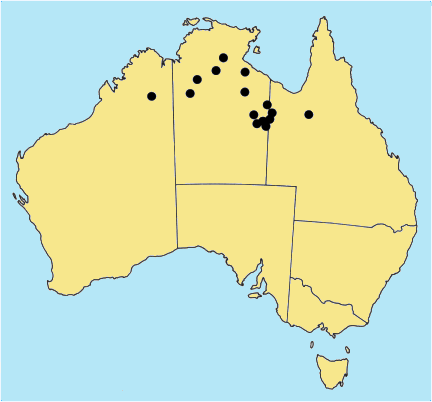Eriachne nervosa Ewart & Cookson. Fl.
North.Terr. 44 (1917).
Classification. (GPWG 2001) : Subfamily
Micrairoideae. Eriachneae.
Type of Basionym or
Protologue Information: Australia, Eva Downs: Hill 923 (MEL holo,
K).
Key references
(books and floras): [1981] M.Lazarides in J.Jessop (ed)., Flora of
Central Australia (442), [2002] D.Sharp & B.K.Simon, AusGrass,
Grasses of Australia.
Habit.
Perennial. Rhizomes present, elongated. Culms erect, stature robust to
moderate, 60–105 cm tall, 3–5 -noded. Mid-culm nodes glabrous. Lateral branches
simple. Ligule a fringe of hairs. Leaf-blades 8–30 cm long, 2–4 mm wide.
Leaf-blade surface glabrous or indumented.
Inflorescence.
Inflorescence compound, a panicle. Panicle linear or oblong, 7.5–22 cm long,
1.5–3.5(–5) cm wide.
Spikelets.
Spikelets pedicelled. Fertile spikelets 2-flowered, both fertile, comprising 2
fertile floret(s), without rachilla extension, ovate, laterally compressed,
11.5–14 mm long.
Glumes.
Glumes similar, thinner than fertile lemma. Lower glume ovate, membranous,
without keels, 13–17 -nerved. Lower glume surface glabrous. Upper glume ovate,
6–8.5 mm long, membranous, without keels, 13 -nerved. Upper glume surface
smooth, glabrous.
Florets.
Fertile lemma 8–14 mm long, without keel, 7 -nerved. Lemma surface indumented.
Lemma apex muticous or mucronate or awned, 1 -awned. Median (principal) awn 2–4
mm long overall. Grain 3–3.5 mm long.
Continental
Distribution: Australasia.
Australian
Distribution: Western Australia, Northern Territory, Queensland.
Western Australia:
Fitzgerald. Northern Territory: Darwin & Gulf, Victoria River,
Barkly Tableland, Central Australia North. Queensland: Burke, Gregory
South.
Notes.
Plants of this species form robust, glaucous tussocks, largely glabrous and
smooth on the vegetative parts, with simple few-noded culms, long coriaceous
usually flat, vesicular blades, and contracted panicles. The large spikelets
feature firm many-nerved glabrous smooth glumes, florets longer than glumes
with divergent lemmas and paleas, and bisulcate shortly awned lemmas. Eriachne
nervosa has similarities with E. benthamii, which occurs in a
similar, but more southerly environment and differs chiefly by its smaller,
awnless spikelets. Also, there are similarities with the westerly E. festucacea,
but this species has long-acuminate obscurely nerved glumes, smaller lemmas,
recurved lemmas and paleas, largely glabrous rootbase and lacks the vesicles on
the blades.
Endemic.
N.T. N of 21ºS, NW Qld, and recorded from W.A. only by Petheram 611. A
characteristic species of the grey to black, cracking clay, grassland plains of
the Barkly Tableland and similar areas, where plants form large stands in or
near swamps, depressions, watercourses, and major drainage channels. Flowers
and fruits in the N.T. and Qld May-Aug. (late-autumn to winter), and also Oct.
(mid-spring); in W.A. in Feb. (late-summer).





